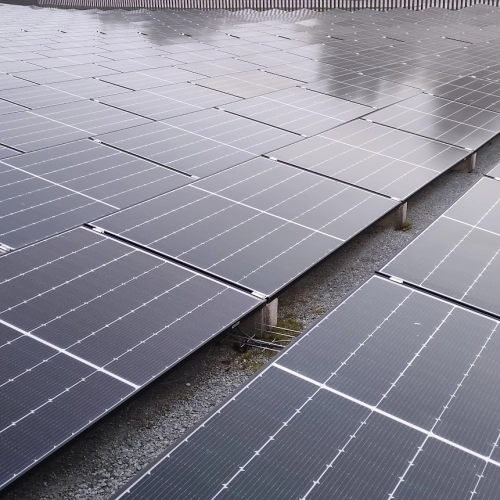
The Sun, that luminous giant at the heart of our solar system, is much more than just a fiery sphere in the sky. Since ancient times, humans have observed and revered the Sun, but today, we are discovering how to harness its energy in innovative and sustainable ways.
The use of the Sun as a source of energy has ancient roots in human history. Since time immemorial, civilizations have harnessed solar energy in various ways to meet their basic needs. An early example is the use of sunlight to provide daytime lighting in homes and structures.
The Sun emits an astonishing amount of energy in the form of electromagnetic radiation. This radiation travels through space and reaches Earth in the form of light and heat. But how can we convert that solar radiation into a usable source of energy?
Origin of the Sun's energy
The Sun's energy is generated through a process known as nuclear fusion. In the core of the Sun, where temperatures and pressures are extremely high, hydrogen atoms fuse to form helium atoms. This process releases a huge amount of energy in the form of electromagnetic radiation, mainly in the form of light and heat.
Nuclear fusion occurs when the nuclei of two hydrogen atoms combine to form a helium nucleus. In this process, a small amount of mass is converted into a large amount of energy, according to Einstein's famous equation, E=mc², where "E" represents energy, "m" represents mass, and "c" represents velocity. of light squared.
In the core of the Sun, where temperatures reach approximately 15 million degrees Celsius and pressures are incredibly high, hydrogen atoms are subjected to ideal conditions for nuclear fusion.
This process releases enormous amounts of energy in the form of light and heat, which is then radiated out into space and reaches Earth in the form of solar radiation.
Historical examples
In ancient times, civilizations such as the Egyptians, Greeks and Romans used the sun as a source of energy ingeniously in the architecture of their buildings.
An emblematic example is the design of atriums in Roman houses, where openings in the roof were used to allow sunlight to illuminate the interior during the day. These atria not only provided natural light, but also helped regulate the interior temperature, taking advantage of the Sun's heat in colder climates and providing shade in warmer climates.
Another historical example of the use of solar energy is the invention of solar ovens. Ancient civilizations, such as the Greeks and Chinese, developed methods of concentrating sunlight using mirrors or lenses to generate high temperatures and cook food or melt metals. Solar ovens continued to be used throughout history in various cultures, demonstrating humanity's ability to harness the Sun's energy in a practical and efficient way.
In addition to lighting and cooking, other ancient applications of solar energy include drying food and obtaining hot water. For example, in ancient Egypt, rudimentary solar panels made of clay were used to heat water in containers during the day, thus providing hot water for baths and other domestic uses.
Photovoltaic Solar Energy
 One of the most common ways to do this is through photovoltaic solar energy.
One of the most common ways to do this is through photovoltaic solar energy.
This process uses solar cells, usually made of silicon, to convert sunlight into electricity. Solar cells contain layers of materials that have special properties: when photons of sunlight hit these layers, they release electrons, generating electrical current.
These solar panels can be installed on the roofs of buildings, in rural areas or even in large solar plants, converting sunlight into clean, renewable electricity.
Thermal solar energy
Another way to harness solar energy is through solar thermal energy. This method uses solar radiation to heat a fluid, such as water or oil, which is then used to generate steam and spin turbines that produce electricity.
Additionally, solar thermal energy can be used to heat water in homes and buildings, thus reducing dependence on fossil fuels for heating and hot water.
Other apps
But solar energy is not only used to generate electricity and heat. Its potential is also being explored in other areas, such as water desalination, agriculture and transportation.
For example, solar desalination systems use the Sun's energy to evaporate salt water and then condense it into drinking water, providing a sustainable solution for freshwater-scarce regions.
In agriculture, solar energy is used to power irrigation systems and provide power to remote farms, reducing costs and dependence on fossil fuels.
Additionally, solar energy is increasingly being used in transportation, with electric vehicles being charged with electricity generated by solar panels.
A source of energy in natural processes
The Sun plays a critical role as an energy source in several natural processes, among which the water cycle and photosynthesis stand out. In the water cycle, solar energy is the engine that drives the continuous movement of water between the Earth's surface, the atmosphere and bodies of water.
Water cycle
The Sun's energy heats the Earth's surface, causing water to evaporate from oceans, rivers and lakes, turning it into water vapor. This vapor rises into the atmosphere, where it cools and condenses to form clouds. These clouds subsequently release water in the form of precipitation, such as rain or snow, which returns to the Earth's surface, replenishing bodies of water and maintaining terrestrial ecosystems.
Photosynthesis
The Sun is also an essential source of energy for plants that absorb it through photosynthesis.
Photosynthesis is a vital process for life on Earth, through which plants, algae and some bacteria convert solar energy into chemical energy to produce their own food.
During photosynthesis, plants absorb sunlight through pigments such as chlorophyll and use this energy to convert carbon dioxide and water into carbohydrates, releasing oxygen as a byproduct.
Advantages and benefits of solar energy
One of the greatest advantages of using the sun as an energy source is its abundance and availability. Unlike fossil fuels, which are finite and contribute to climate change, the Sun will continue to shine for billions of years, providing a clean, renewable source of energy.
Additionally, solar energy is becoming more affordable and accessible, making it an attractive option for communities around the world.
Limitations of this energy source
However, solar energy also presents challenges. The availability of sunlight can vary depending on geographic location and weather conditions, which can affect the efficiency of solar systems.
Additionally, solar technology still faces hurdles in terms of energy storage and long-distance transportation.